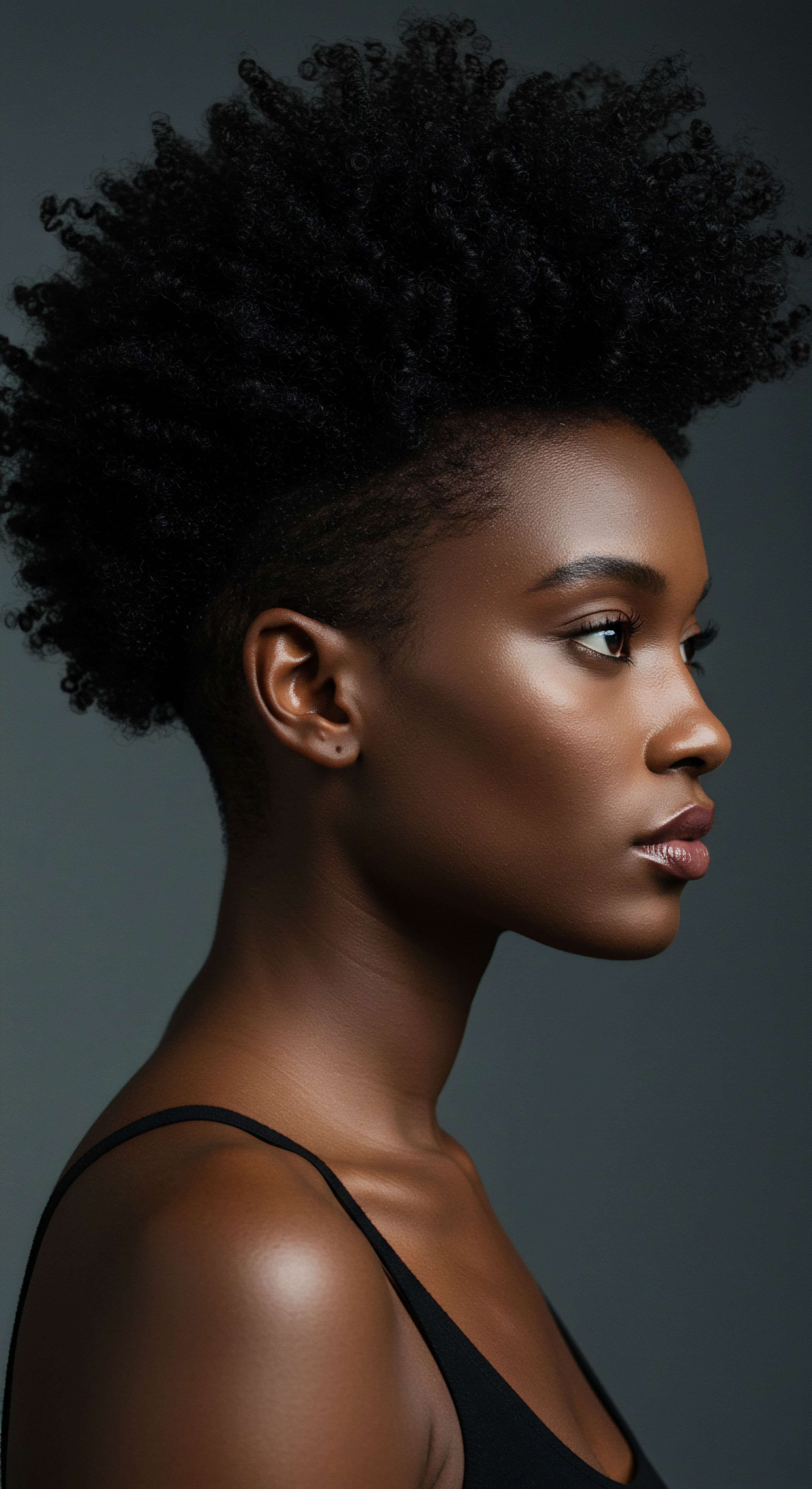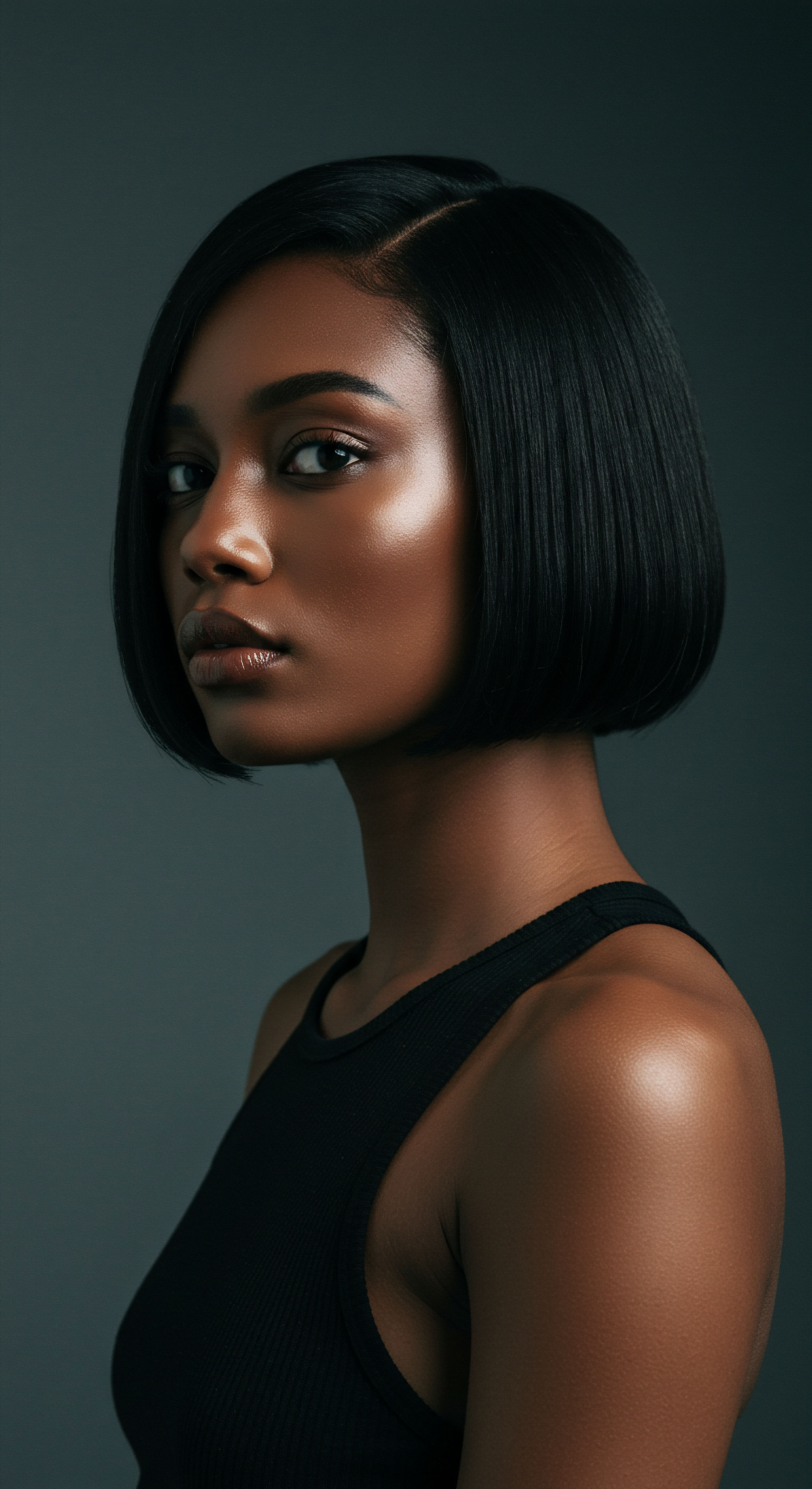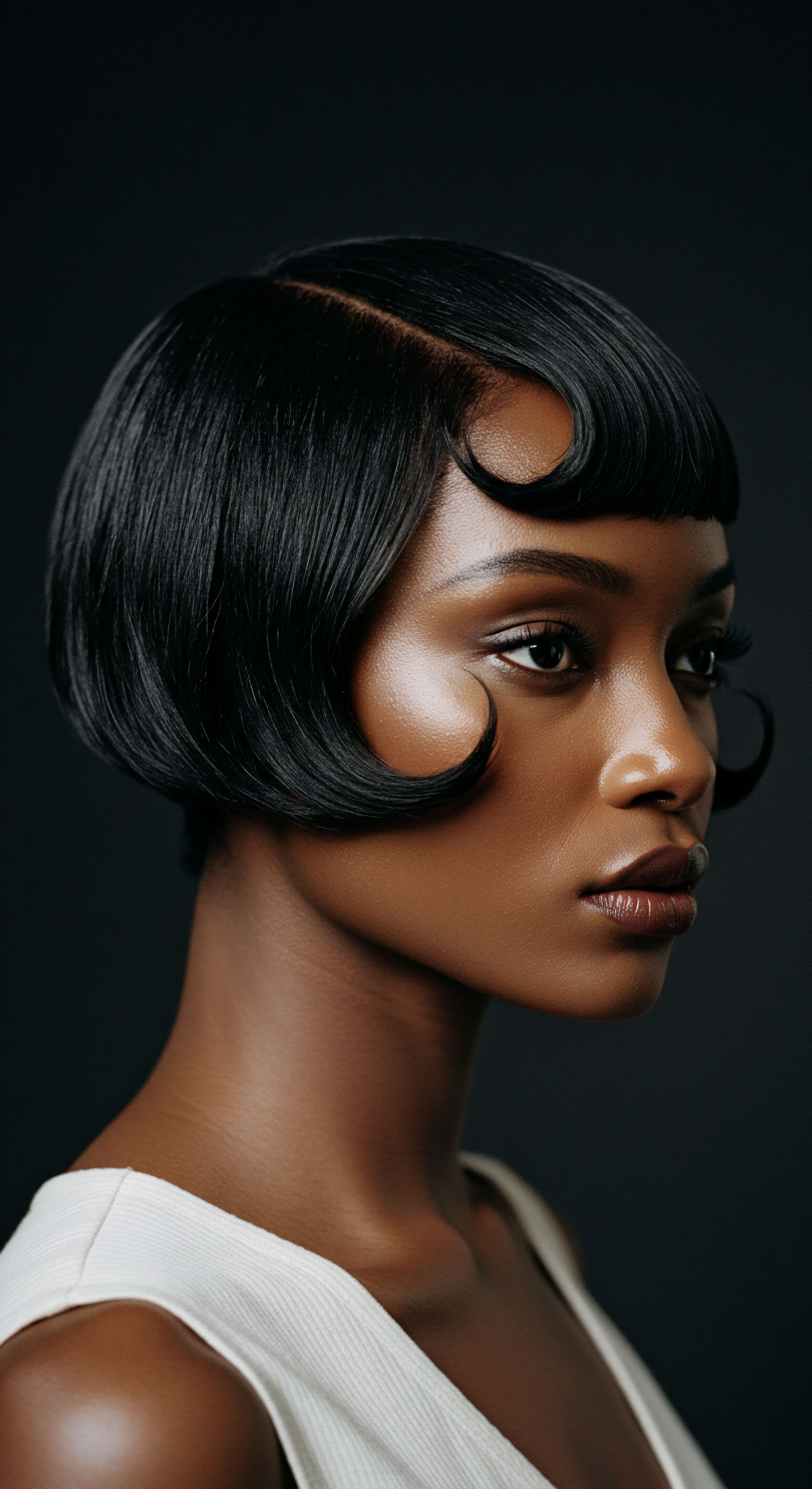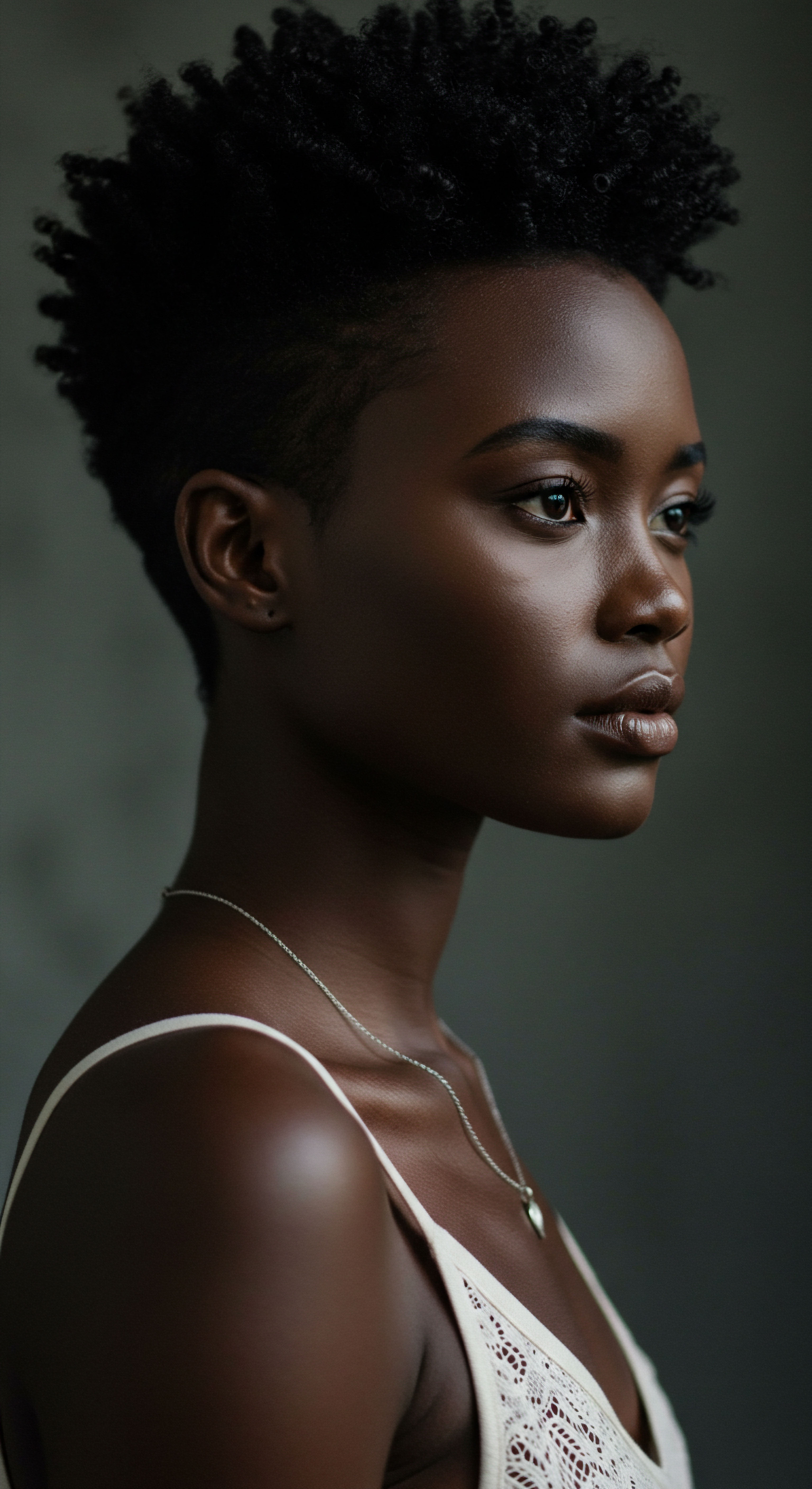
Roots
The whisper of water on a parched earth, the gentle hum of life finding its way through the deepest roots – these are the quiet observations that lead us to understand hair at its most fundamental. Coily hair, with its unique architecture, holds secrets to moisture that are both a gift and a challenge. To truly grasp how henna, an ancient botanical ally, interacts with these intricate strands, we must first settle into the very core of what coily hair is, and what henna brings to its surface. It is a dialogue between plant and strand, a story etched in the very fiber of being.

The Architecture of Coily Hair
Coily hair, often recognized by its tight spirals and zigzag patterns, presents a distinct morphology that sets it apart from straighter textures. Its elliptical follicle shape causes the hair shaft to emerge at a sharp angle, forming those beautiful, compact coils. This inherent curvature means that the natural oils produced by the scalp, known as sebum, struggle to travel down the entire length of the hair strand. The journey is simply too circuitous, leaving the ends particularly vulnerable to dryness.
At a microscopic level, the cuticle, the outermost protective layer of the hair, behaves differently on coily strands. While the cuticle layers of straight hair lie flat and smooth, those on coily hair are not as tightly arranged, exhibiting a more lifted or open disposition. This natural lift contributes to the perception of volume, yet it also means coily hair can readily allow moisture to escape, making moisture retention a constant pursuit. The cortex, the inner strength of the hair, also exhibits a flatter shape in coily hair, contributing to its unique properties.

Why Does Coily Hair Dry So Quickly?
The question of coily hair’s quick drying often arises. It stems from a confluence of factors inherent to its structure. The tight coiling physically impedes the downward movement of sebum, a natural conditioner. Beyond this, the cuticle scales, while serving a protective role, are smaller and more prone to lifting on coily hair compared to other hair types.
This allows water to enter and exit the hair shaft more freely. When the hair is wet, water can absorb quickly, but without a sealed cuticle, that moisture dissipates just as readily into the air. This constant cycle of absorption and release can lead to a sensation of dryness and brittleness if not managed with consistent care.

Henna’s Fundamental Interaction
Henna, derived from the powdered leaves of the Lawsonia inermis plant, contains a potent dye molecule known as lawsone, or 2-hydroxy-1,4-naphthoquinone. This molecule is the heart of henna’s transformative power. When mixed with an acidic liquid and allowed to release its dye, lawsone develops an affinity for the keratin protein that makes up our hair. This chemical interaction is central to how henna impacts hair.
Lawsone molecules bond with the keratin in the hair shaft through a process akin to a Michael addition reaction. This is not merely a surface coating, though it can appear that way. Instead, the lawsone migrates into the outer layers of the keratin, staining them permanently. This bonding creates a layer of color and also, crucially, reinforces the hair shaft.
Henna’s lawsone molecule forms a lasting bond with hair’s keratin, a fundamental interaction that changes the hair’s very structure.
This binding mechanism has profound implications for how coily hair absorbs and retains moisture. By depositing within the outer layers of the hair, henna can alter the hair’s surface topography.
- Lawsone ❉ The primary pigment in henna, responsible for its staining properties and interaction with keratin.
- Keratin ❉ The protein that forms the structural foundation of hair, to which lawsone binds.
- Cuticle ❉ The outermost protective layer of the hair, whose condition significantly influences moisture absorption.
| Hair Component Follicle Shape |
| Coily Hair Characteristic Elliptical, creating tight coils |
| Henna's Influence No direct change, but effects on curl pattern may be perceived |
| Hair Component Cuticle Layer |
| Coily Hair Characteristic Naturally lifted, allowing moisture escape |
| Henna's Influence Lawsone binds to outer layers, potentially sealing or reinforcing |
| Hair Component Sebum Distribution |
| Coily Hair Characteristic Difficult travel down hair shaft |
| Henna's Influence Henna does not directly alter sebum, but can influence hair's moisture needs |
| Hair Component Understanding these basic interactions lays the groundwork for deeper insights into henna's effects. |

Ritual
The careful hands preparing the mixture, the patient wait as nature performs its subtle transformation, the gentle rinse revealing something new – these are the moments that comprise the ritual of hair care. For those with coily hair, every application, every touch, holds the potential for either profound nourishment or unexpected challenges. When henna becomes part of this ritual, its practical application and the subsequent care routines hold the key to understanding its full effect on moisture. It is in the mindful practice that we truly come to know the plant’s power.

Preparing for Henna Application
The journey with henna often begins with thoughtful preparation. The quality of the henna powder itself is paramount; only body art quality (BAQ) henna, free from metallic salts or additives, should ever grace coily strands. Such adulterants can react negatively with subsequent chemical treatments, even causing hair damage. The chosen liquid for mixing the henna paste also plays a significant role.
Acidic liquids, such as distilled water with a touch of apple cider vinegar, or even hibiscus tea, are often favored to aid in the dye release of lawsone. However, care must be taken with highly acidic mixes, as a pH lower than approximately 3.6 can potentially cause permanent damage to the hair, making it rougher over time.
Some practitioners suggest adding oils or other moisturizing agents to the henna paste, such as coconut milk or yogurt, to mitigate a perceived drying effect. However, research indicates that these additions can inhibit proper dye uptake, making the lawsone less effective in binding to the keratin. Instead, addressing moisture concerns should occur through pre- and post-henna conditioning.

Henna and Hair Porosity
A common point of discussion among those considering henna is its perceived effect on hair porosity. Henna binds its pigment into the hair structure, a chemical process that can lead to a sensation of dryness initially. Some suggest that henna makes hair high porosity, meaning it absorbs moisture quickly but struggles to hold onto it. However, other perspectives contend that henna, by binding to the keratin and forming a protective layer, can actually help to fill in gaps in the hair shaft, making it feel smoother and more structured, particularly for hair that is already high porosity.
The initial sensation of dryness after henna application is often a temporary textural change, not necessarily a lasting moisture deficit.
This apparent contradiction highlights the complexity of hair science. The “dryness” many experience after henna application is often a textural change, a feeling of increased coarseness or stiffness, rather than an actual lack of water within the hair shaft. This is because the lawsone molecules bind to the hair, creating a more reinforced, less pliable strand. This can make the hair feel less soft or “moisturized” to the touch, even if its internal moisture content is adequate.

Does Henna Change Hair’s Ability to Absorb Water?
The question of whether henna truly changes hair’s ability to absorb water is multifaceted. While henna can create a protective layer around the hair shaft, it does not entirely seal it off from external moisture. The lawsone migrates into the outer layers of keratin, rather than forming an impermeable coat on the surface. This means that henna-treated hair can still absorb water and conditioning products, though the perception of absorption might differ due to the altered texture.
For those with low porosity coily hair, where the cuticle is already tightly closed, henna’s protein-binding effect might make the cuticle even tighter. This can, over time, contribute to increased brittleness and potential breakage if not balanced with appropriate moisturizing routines. Conversely, for hair with higher porosity, henna’s ability to fill in gaps in the cuticle can be beneficial, aiding in moisture retention by providing a smoother, more structured surface.
- Pure Henna ❉ Select only 100% pure, body art quality (BAQ) henna to avoid metallic salts and additives that can cause damage.
- Acidic Liquid ❉ Mix henna with an acidic liquid like distilled water with apple cider vinegar or hibiscus tea for optimal dye release, ensuring the pH is not too low.
- Post-Henna Conditioning ❉ Follow henna treatments with deep conditioning to counteract any temporary dryness and restore softness.
| Hair State Feel |
| Immediate Post-Rinse Potentially dry, coarse, or stiff |
| With Proper Aftercare Smoother, softer, more manageable |
| Hair State Porosity Perception |
| Immediate Post-Rinse May feel like high porosity due to initial dryness |
| With Proper Aftercare Can help seal cuticle for high porosity hair, improving retention |
| Hair State Curl Pattern |
| Immediate Post-Rinse May temporarily loosen due to added weight/reinforcement |
| With Proper Aftercare Curl pattern should return, though some may perceive slight relaxation |
| Hair State The experience of henna on hair evolves with diligent care. |

Relay
Beyond the surface observations and the daily rituals, lies a deeper dialogue, a convergence of ancient wisdom and modern scientific inquiry. How does henna truly alter coily hair’s moisture absorption over time, when we peer into the very cellular fabric and consider the broader context of its interaction? This is where the nuanced conversation begins, where we connect the microscopic with the lived experience, inviting a profound insight into the enduring relationship between plant and strand.

The Microscopic Reinforcement
Henna’s interaction with hair is more than a simple surface coating; it involves a chemical bond between the lawsone molecule and the keratin protein within the hair shaft. This bond, a Michael addition reaction, means the lawsone integrates into the outer layers of the hair’s cortex, beneath the cuticle. This integration provides a form of internal reinforcement.
A study evaluating the morphological effect of Lawsonia inermis (henna) on hair using Scanning Electron Microscopy (SEM) revealed a positive impact on the cuticle pattern and an increase in the diameter of the hair samples after henna application. This suggests that henna contributes to the hair’s structural integrity, making individual strands feel thicker and more substantial.
This added substance can influence how coily hair interacts with moisture. When the hair shaft gains this internal reinforcement, it can become less prone to excessive swelling and contraction with changes in humidity. This stability can lead to a more consistent moisture level within the hair, rather than rapid absorption and subsequent loss.

Does Henna Make Coily Hair Less Responsive to Moisture?
The notion that henna makes coily hair less responsive to moisture is a common misconception, often stemming from the initial textural changes observed. While the hair may feel coarser or stiffer immediately after a henna application, this is largely due to the lawsone binding and reinforcing the keratin. This does not equate to a complete impermeability to water.
Instead, the effect can be more accurately described as a modification of moisture dynamics. Henna can aid in moisture retention by helping to smooth down the cuticle, particularly for hair that might have a more open cuticle due to its coily structure or prior damage. By filling in microscopic gaps and creating a more cohesive surface, henna can reduce the rate at which moisture escapes, even if the initial absorption feels less rapid than on untreated, highly porous hair. This is particularly relevant for high porosity coily hair, where protein treatments, which henna effectively is, are often recommended to fill cuticle gaps and aid in moisture retention.

The Paradox of Henna and Hair Elasticity
One of the most debated aspects of henna use on coily hair involves its effect on elasticity and curl pattern. While some users report a temporary loosening of their curl pattern, others experience increased curl clumping and definition. This apparent paradox speaks to the complex interplay of henna with the hair’s protein structure.
Henna, by binding to keratin, can indeed add weight and reinforce the hair shaft. For some coily hair types, particularly finer strands, this added weight might temporarily relax the curl pattern, making it appear less tightly coiled. However, this is generally a temporary effect that tends to diminish with washing. Conversely, for hair that struggles with definition, the structural reinforcement from henna can promote better curl clumping and a more defined appearance, as the individual strands become more cohesive.
Henna’s effect on curl pattern is often temporary and can vary based on individual hair characteristics, rather than a universal straightening.
A notable study on the morphological effect of henna on hair, using Scanning Electron Microscopy, observed that henna application had a “positive impact on the cuticula pattern and on the diameters of the examined samples”. This finding supports the idea that henna reinforces the hair, which can alter its mechanical properties, including how it responds to moisture and how it forms its natural coil. The study provides empirical evidence that henna does more than simply color; it physically changes the hair’s structure at a microscopic level, leading to changes in how the hair feels and behaves.
It is also worth noting that the perceived “dryness” or “brittleness” some experience after henna is sometimes linked to protein overload, as henna is a protein-rich treatment. If a coily hair strand is already protein-sensitive or has low porosity, excessive or frequent henna applications can lead to stiffness and breakage. This highlights the need for balance and understanding one’s hair’s specific needs, ensuring deep conditioning and moisture are consistently supplied.

Cultural Context and Modern Application
Henna’s journey through time and cultures offers a rich context for its modern use. Across North Africa, the Middle East, and South Asia, henna has been revered for thousands of years, not solely for its coloring properties, but also for its medicinal and conditioning benefits. Ancient Egyptians used henna for cosmetic and spiritual purposes, adorning mummies with henna-stained hair and nails, believing in its protective qualities. In India, “mehndi” ceremonies involving intricate henna designs symbolize love, prosperity, and joy, particularly in weddings.
This historical use as a conditioning agent speaks to an ancestral understanding of henna’s ability to fortify hair. Traditional practices often involved mixing henna with various herbs and oils, creating holistic treatments that went beyond mere color application. This cultural heritage informs a modern approach to henna for coily hair, where its use is viewed not just for its aesthetic dye, but for its potential to contribute to hair strength and health, when applied with care and awareness of its unique properties.
- Lawsone Binding ❉ The lawsone molecule from henna chemically bonds with hair keratin, reinforcing the hair shaft.
- Cuticle Refinement ❉ Henna can help smooth the cuticle layer, particularly for high porosity hair, aiding in moisture retention.
- Protein Balance ❉ Coily hair benefits from balancing henna’s protein-rich effects with ample moisturizing treatments.
| Aspect of Hair Strand Diameter |
| Observed Effect with Henna Can increase, making hair feel thicker |
| Underlying Mechanism Lawsone integration into outer keratin layers |
| Aspect of Hair Moisture Retention |
| Observed Effect with Henna Can improve by smoothing cuticle, reducing moisture escape |
| Underlying Mechanism Lawsone binding fills cuticle gaps, creates cohesive surface |
| Aspect of Hair Elasticity/Curl |
| Observed Effect with Henna Temporary loosening or enhanced clumping |
| Underlying Mechanism Added weight/reinforcement, can be balanced with care |
| Aspect of Hair The sustained interaction of henna with coily hair offers both benefits and considerations for long-term care. |

Reflection
The journey through henna’s interaction with coily hair reveals a complex, yet profoundly beautiful, interplay. It is a dialogue between ancient botanical wisdom and the precise science of our strands, a conversation that invites us to listen closely to our hair’s unique language. Henna, with its remarkable lawsone molecule, does not simply color; it engages with the very essence of hair, altering its surface, reinforcing its structure, and reshaping its relationship with moisture.
The experience, as we have seen, is rarely monolithic, often reflecting the unique porosity and care practices of each individual. Understanding this delicate dance, appreciating the historical reverence, and applying modern scientific insight allows us to approach henna not as a fleeting trend, but as a timeless ally in the nuanced art of coily hair care.

References
- Syed, Ali Naqi. Curly Hair ❉ Structure, Properties, and Care. Hasnia Publishing, 2024.
- Davis-Sivasothy, Audrey. The Science of Black Hair. Saja Publishing Company, 2011.
- “The History of Henna in Traditional Persian Medicine and Ayurveda.” THE EAST TO WEST LIFESTYLE CO, 2024.
- “The History and Cultural Significance of Henna in Hair Coloring.” Reshma Beauty, 2024.
- “Side effects to Henna? 8 Answers for Curly Hair.” HONESTLIZ.
- “3 Reasons Why Henna Isn’t Recommended for Natural Hair.” Black Curl Magic.
- “The History and Origins of Henna Powder ❉ A Natural Dye with a Rich Legacy.” 2025.
- “The Intricacies of Henna’s History and Cultural Significance.” Aramco Expats, 2023.
- “Henna ❉ The Surprising Story Behind This Ancient Art.” BeautyAList.
- “Side effects of Hair colouring ❉ There are many disadvantages of applying henna to hair.” The Times of India, 2025.
- “The truth about Henna (Lawsonia inermis).” 2023.
- “Is henna very drying? I already have dry curly/wavy hair and have read it coats the hair so moisture won’t enter the cuticle which would cause breakage for my already dry hair. I’m deathly allergic to pdd but like my hair really dark. I’ve read henna then indigo. Any advise welcome.” Reddit, 2025.
- “Henna curly hair ❉ advantages and disadvantages.” I Love Riccio.
- “Full Coverage ❉ Why Hair Feels Dry After Henna and How to Fix It.” Ancient Sunrise, 2017.
- “Waves, Curls, and Coils ❉ Understanding Curly Hair Types from a Trichologist.” 2023.
- “An Overview on Hair Porosity.” NYSCC, 2020.
- “Is Henna Hair Dye a Bad Idea? Here’s What the Experts Have to Say.” Healthline, 2021.
- “Lawsone.” Wikipedia.
- “Side effects of using Mehendi on your hair.” The Times of India, 2024.
- “NAPHTHOQUINONES ❉ BIOLOGICAL PROPERTIES AND SYNTHESIS OF LAWSONE AND DERIVATIVES – A STRUCTURED REVIEW.”
- “SCIENTIFIC study I found on henna for hair! soo happy! Great research that shows HOW henna works on hair.” Reddit, 2021.
- “The Henna pigment Lawsone activates the Aryl Hydrocarbon Receptor and impacts skin homeostasis.” PMC – PubMed Central.
- “Possible interactions between hair fibers and lawsone (a).” ResearchGate.
- “Isolation and Identification of Lawsonia Content from Leaves of Henna (Lawsonia inermis).” UMT Journals, 2023.
- “How to Use Henna To Dye and Nourish Your Hair.” Kama Ayurveda, 2020.
- “Effect of Hair Straightening Treatment on Porosity and Cysteic Acid Content of Hair.” Journal of Advances in Medicine and Medical Research, 2020.
- “Natural Hair Dye Henna Hair Colour Medium Brown 100% Pure Organic Chemical Free Herbal Powder 100g (1 Pack) by Indus Valley.” Amazon UK.
- “Porosity at Different Structural Levels in Human and Yak Belly Hair and Its Effect on Hair Dyeing.” MDPI.
- “The Ultimate Guide to High Porosity Hair ❉ Moisture Solutions.” Dr. Serkan Aygin, 2025.
- “Porosity and Resistance of Textured Hair ❉ Assessing Chemical and Physical Damage Under Consumer-Relevant Conditions.” ResearchGate, 2025.
- “Can you apply color on henna treated dry damaged hair?” Quora, 2019.
- “Clinical and anthropological perspectives on chemical relaxing of afro-textured hair.” ResearchGate.
- “Towards Elucidation of the Reaction Mechanism between Lawsone and Amino Acids.” FLEX, 2021.
- “Henna and Me ❉ 6 Months Later.” The Kink And I, 2015.
- “Top Things to know about Henna Hair Dye | Hair Dye FAQ.” Lush.
- “The irresistible benefits of henna for natural afro hair.” Its Elixir, 2023.
- “Isolation, identification and characterization of lawsone from henna leaves powder with soxhlet technique.” ResearchGate.
- “OPINION ON Lawsonia inermis (Henna).” EC Europa.